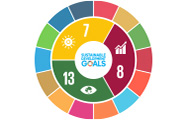Performance highlights
This table represents a selection of global metrics that we track within Shell. These metrics have been selected because they reflect the direct impact of Shell companies’ operations on people and the environment. We used them to set our goals and measure progress in 2019 and to define priorities for 2020.
We review our metrics regularly to ensure we capture the information needed to improve our performance. For example, we introduced Goal Zero for personal safety at Shell in 2007. Since then, we have broadened the goal to aim for no harm to people and the environment. More information on our performance, definitions of the indicators and the referenced goals is provided in the environmental, social and safety data sections.
Goals, performance and plans
Personal safety
Personal safety
Goal 2019
TRCF ≤ 0.7
Achieve total recordable case frequency (TRCF) – the number of injuries per million working hours – of 0.7 or below for employees and contractors.
Goal Zero has been our ambition for personal safety since 2007.
Progress in 2019
Total recordable case frequency (TRCF)
The TRCF was 0.9 in 2019; the same as in 2018 (see Safety performance).
Priorities in 2020
- Start to deploy a new approach to safety with a more consistent focus on the way people, culture, equipment, work systems and processes interact.
- In road safety, continue to focus on effective implementation of proven practices across all lines of business, with an emphasis on improving the management of fuel transport in high-risk countries. Work with road transport contractors to increase the use of advanced technology to support safe driving.
- Support the development and implementation of common industry safety standards.
- Improve our capabilities to learn from audit findings and investigations into incidents with the potential to cause harm.
Process safety
Process safety
Goal 2019
Leaks ≤ 115
Reduce the number of operational leaks to 115 or below (classified as “operational Tier 1 and 2 process safety events”).
Since 2011, we have extended our ambition of Goal Zero to process safety.
From 2017, we combined operational Tier 1 and 2 safety events when setting the target. Previously, we only used Tier 1 events.
Progress in 2019
Number of operational Tier 1 and 2 process safety events
The number of Tier 1 and 2 operational process safety events increased from 121 in 2018 to 130 in 2019 (see Safety performance).
Priorities in 2020
- Continue to focus on asset integrity and quality of operational execution by, among other things, shifting attention to leading indicators to understand and measure success, embedding our Process Safety Fundamentals, and rolling out a group-wide asset management system.
- Continue to improve learning from process safety events with high potential impacts.
Environment
Environment
Goal 2019
Goal Zero extends to the environment with our goal of no operational spills.
Progress in 2019
Volume of operational spills in ‘000 tonnes
The number of operational spills fell from 93 in 2018 to 70 in 2019. The volume of operational spills of oil and oil products in 2019 was 0.2 thousand tonnes, a decrease from 0.9 thousand tonnes in 2018 (see Environmental performance).
Priorities in 2020
- Continue to learn from incidents with spills to improve the reliability of our facilities and further reduce the number and volume of operational spills.
- Continue to work with the oil and gas industry to further develop effective oil spill response capacities.
GHG and Energy
GHG and Energy
Goal 2019
Reduce flaring in our Upstream business.
Our policy is to reduce flaring and venting to as low a level as is reasonably practical.
We are a signatory of the World Bank’s Zero Routine Flaring by 2030 initiative.
Progress in 2019
Upstream flaring: million tonnes CO2 equivalent [A]
[A] Includes Upstream and Integrated Gas.
Our upstream flaring increased to 5.9 million tonnes of CO2 equivalent in 2019 from 5.2 million tonnes in 2018 (see Flaring).
Priorities in 2020
- Continue to link staff bonuses to the management of greenhouse gas emissions.
- Further embed the guiding principles for reducing methane emissions in the gas industry, which Shell and seven other energy companies signed in November 2017.
- Continue to focus on maintenance measures to enhance the reliability of our equipment and reduce emissions through leaks.
GHG and Energy
Goal 2019
Upstream and Integrated Gas GHG intensity ≤ 0.168
For our Upstream and Integrated Gas facilities, achieve a GHG intensity of 0.168 tonnes or below of CO2 equivalent per tonne of hydrocarbon production available for sale.
Progress in 2019
Upstream and Integrated Gas: tonnes CO2e per tonne of hydrocarbon production available for sale
Our Upstream and Integrated Gas GHG intensity was 0.168 tonnes CO2 equivalent per tonne of hydrocarbon production available for sale in 2019 compared with 0.158 in 2018.
Priorities in 2020
GHG & Energy
Goal 2019
Refinery GHG intensity ≤ 1.06
For our refineries, reduce GHG intensity to 1.06 tonnes or below of CO2 equivalent per Solomon’s Utilised Equivalent Distillation Capacity (UEDC).
Progress in 2019
Refineries: tonnes CO2e per Solomon’s UEDC
Refinery GHG intensity in 2019 was 1.06 tonnes CO2e per UEDC compared with 1.05 in 2018.
Priorities in 2020
GHG & Energy
Goal 2019
Chemicals GHG intensity ≤ 1.00
For our chemical plants, reduce GHG intensity to 1.00 tonnes or below of CO2 equivalent per tonne of high-value petrochemicals produced.
Progress in 2019
Chemicals: tonnes CO2e per tonne of petrochemicals produced
Chemical GHG intensity was 1.04 tonnes CO2 equivalent per tonne of high-value petrochemicals produced in 2019 compared with 0.96 in 2018.
Priorities in 2020
Social performance
Social performance
Goal 2019
Effective community feedback.
- Enhance our online community feedback tool aiming to assess feedback effectively and respond quickly to concerns, based on the improvement areas identified in 2018.
- Identify further improvement opportunities for our community feedback mechanism (CFM) based on a self-check exercise.
Progress in 2019
- Our online community feedback tool was developed after completing pilot tests at several sites. The new tool provides fast and mobile access for employees engaging with communities to help resolve issues quickly.
- Based on an annual social performance assessment, we identified 31 sites in need of further assessment of the effectiveness of CFMs. For these assessments, we used a checklist informed by the UN Guiding Principles for Business and Human Rights. Twenty-three sites implemented CFMs well, with clear procedures, dedicated employee focal points and leadership oversight, and with feedback that was well understood and addressed. For the other eight sites, we developed improvement plans primarily to ensure more effective standardisation for community feedback across sites.
Priorities in 2020
- Introduce the new online community feedback tool to reduce the workload for Shell employees and improve tracking and reporting of feedback.
- Implement improvement plans at priority CFM sites to enable a proactive approach.
 Climate change
Climate change
 Sustainable development goals
Sustainable development goals
 Safety
Safety
 About our data
About our data
